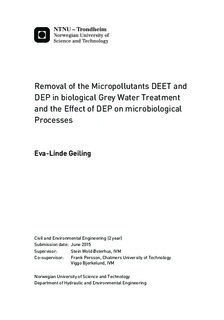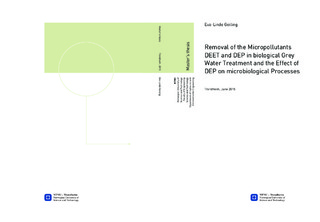| dc.description.abstract | The insect repellent N,N-diethyl-m-toluamide (DEET) and the plasticizer Diethyl Phthalate (DEP) are commonly used in externally applied personal care products. Washed off the skin, they are found in grey water. If the grey water is reused for high body contact applications in order to lower the potable water demand, the removal efficiency for these micropollutants (MP) during treatment is crucial. The presented Master s thesis quantifies the removal of DEET and DEP during biological grey water treatment. It evaluates the effect of DEP on microbial processes and nutrient removal.
Beakers spiked with 2.5, 5, 10 µg/L DEET and 10, 50, 100 µg/L DEP were aerated for 3.5h and 6h. Residual MP concentrations were measured with a high performance liquid chromatography (HPLC). Therefore, samples had to be purified and up-concentrated 200 times (DEP) and 500 times (DEET) with a solid phase extraction (SPE).
Biological phosphorous removal, nitrification and de-nitrification under the influence of 0 and 100 µg/L DEP were quantified. Oxygen uptake rates and metabolic activity under the influence of 0 to 10 000 µg/L DEP were measured. TOC removal under the influence of both MP was determined in all set-ups. Selected samples were analyzed with size exclusion chromatography (LC-OCD).
At minimum, 11.7% (13.4 %) DEET, i.e. 0.12 µg/gSS (0.17 µg/gSS) is removed during 3.5h (6h) aeration. DEET does not adsorb onto sludge.
At minimum, 86.9% (100%) DEP, i.e. 2.2µg/gSS (2.3 µg/gSS), is removed during 3.5h (6h) aeration. 6.6% DEP, i.e. 2 µg/gSS, adsorb onto sludge.
None of the compounds evaporates during biological treatment.
Biological phosphorous and nitrogen removal are not significantly influenced by 100 µg/L DEP. In contrast, TOC removal is severely hampered by the presence of >50 µg/L DEP. Depending on retention time, 100 µg/L DEP decreases the TOC removal efficiency by up to 47.7%. The residual TOC in the spiked beaker is up to 39 mg/L higher than in the blank. The increased residual TOC consists of low molecular weight substances (<< 350 g/mol).
DEP concentrations between 100 µg/L and 10 000 µg/L trend to increase the oxygen uptake rate. This suggests that DEP poses oxidative stress on cells. In this case, the increased residual TOC would indicate cell damage. However, elevated TOC levels can also be caused by overproduction of extracellular polymeric substances as a successful defense against the environmental stress factor DEP. In this case, the effect of DEP on microbes in the activated sludge has to be considered less harmful. | |

